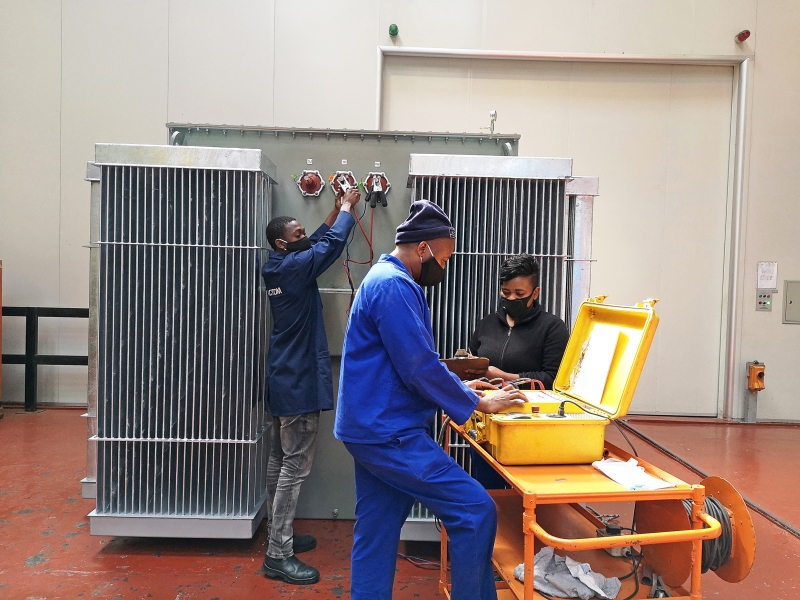A contract awarded to ACTOM Distribution Transformers in March this year to manufacture specialised renewable energy transformers for a new solar photovoltaic (solar PV) plant in the Northern Cape had to be fast-tracked due to a delay resulting from the national lockdown aimed at limiting the spread of Covid-19.
The severely restrictive early stages of the lockdown placed a hold on business activities and production until the beginning of June. “We introduced overtime work to meet the deadline of end-August for completion of the contract. We therefore performed the whole contract in three months, in place of the period of about 5-1/2 months that had originally been scheduled for it,” commented Lee Mbenge, Distribution Transformers’ Projects Manager.

Chief of Test Ms Khuliso Mutheiwana (seated) monitors Test Technician John Seloga (centre) and Junior Projects Engineer Augustine Baloyi as they conduct a test on one of the renewable energy transformers for the Greefspan No.2 solar PV park in the Northern Cape.
The contract comprised the design, manufacture and full type and special testing of the first unit, then manufacture and supply of the balance of 12 x 5.1MVA 33kV/660-660V liquid immersed, hermetically sealed renewable energy transformers for the Greefspan No.2 solar park located near Douglas in the Northern Cape as part of Round 4 of the national Renewable Energy Independent Power Producer Procurement Programme (REIPPPP). The plant will have a total production capacity of 55MW.
Distribution Transformers’ client, Siemens Gamesa Renewable Energy (Pty) Ltd, the EPCM contractor for the project, stipulated that the units had to be able to withstand higher harmonic content that is generated by the Pulse Width Modulation (PWM) convertors without damage or degradation.
The division was required to prove this in advance by conducting a temperature rise test on the first unit it manufactured. “This was successfully conducted at a higher loading factor, taking into account the additional losses that would be generated by the higher harmonic content,” Lee pointed out.
A further noteworthy feature in the design of the transformers is that they incorporate two independent low voltage compartments instead of just one.
“This is a relatively new feature which was also incorporated in the design of transformers we produced in a previous successful concentrated photovoltaic (CPV) plant contract we have done,” Lee said.
“Each of the two LV compartments is linked separately to an inverter in the solar plant. This ensures continuity of supply, because if one happens to fail the other will continue to operate at its full capacity and maintain supply of power into the grid without generating any internal hot-spots which may be generated by leakage flux,” he explained.
